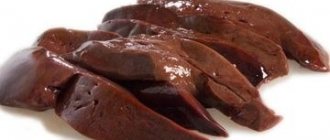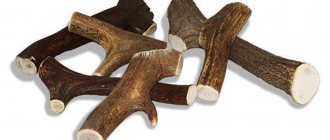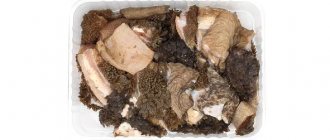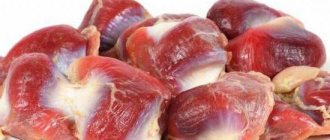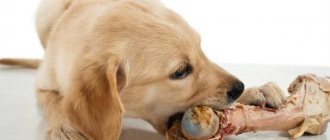Poultry giblets, especially chicken gizzards, are added to the domestic dog's food after the dog has developed its permanent teeth.
Meat by-products contain large amounts of protein, which contributes to the growth of the animal.
In winter, it is important to diversify your dog’s diet by adding foods containing vitamin D, A, iron, and phosphorus. Chicken giblets (stomachs) can be such a source of microelements.
Beneficial features
Chicken giblets contain approximately 20–22% animal protein, muscle fiber, less than 1% fat, iron, and folic acid.
Protein stimulates the development of muscle mass, organs and systems. Iron improves the quality of blood. Vitamin B9 (folic acid) stimulates the rapid restoration of damaged tissues, proper growth and development of the pet.
Fiber improves the dog's digestion, removes harmful substances from the intestines, and helps maintain healthy microflora in the stomach.
Chicken feet
A controversial issue among dog breeders. Some claim that they feed their pets with their paws without fear for their health. The latter are wary of such an offal.
Undoubtedly, the paws are very useful, they contain cartilage and are equal in nutritional value to the heads. But what makes the product dangerous is its claws and tubular bones. Therefore, older dogs can be given paws by cutting off the claws and removing the main tubular bone.
It is useful for puppies to cook jellied meat from poultry paws; this will only help strengthen bones and develop the skeleton.
How do by-products affect the condition of animals?
In a pet's diet, by-products should make up no more than 15% of the total food. They are given as the main food 2 times a week or daily in small portions.
Dog breeders note that their pets, whose diet was supplemented weekly with chicken giblets, had improved general condition and their coat became shiny and smooth.
Such animals endure the winter period without any special health problems; they do not suffer from vitamin deficiency. Pets become stronger and more resilient.
The benefits are visible after just a month of eating offal.
It is rare for dogs to be allergic to animal protein. It manifests itself as vomiting, diarrhea, and indigestion. This may indicate an individual intolerance to the offal or its excess in dog food.
Allergy to chicken in a dog
Chickens, along with other foods, sometimes cause an allergic reaction. Chicken protein intolerance is often found in dogs; some breeds (dachshunds, Labradors, bulldogs, etc.) are predisposed to food intolerance. It is necessary to responsibly plan the diet of sensitive individuals.
Symptoms:
- skin itching;
- rash;
- discharge;
- edema;
- unpleasant odor;
- digestive disorder.
Because of the itching, the dog begins to scratch the skin, it may peel, redness, papules form near the anus, in the abdomen, armpits, on the face, often the irritated areas become wet and covered with crusts. Discharge appears from the eyes, ears, nose, and swelling occurs. The fur begins to smell bad and diarrhea appears.
The allergic condition has an individual character, one dog eats a certain food in large quantities, and another will have a negative reaction.
The allergen is determined by adjusting the feeding; if chicken is suspected, it is completely removed from the diet and the dog’s condition is monitored. The main method of treating food allergies is diet. In some cases, the veterinarian recommends switching the dog to special food.
Usually, after eliminating the allergen, the symptoms quickly go away, but sometimes drug intervention is required to prevent complications; antihistamines, antipruritic ointments and antiseptics, diuretics that help eliminate swelling are used, and immunomodulatory medications are additionally prescribed by the veterinarian. Medicines are selected individually; effective treatment of the dog will only be carried out by a veterinarian.
Raw stomachs: benefits and harms
When asked whether raw offal can be given to animals, dog lovers and veterinarians have different answers. Breeders recommend natural food in raw form. Doctors have reason to criticize this way of feeding animals.
Veterinarian advice
Veterinarians do not advise feeding dogs raw meat: there is a high probability of infection with parasites. It is recommended to stew chicken by-products .
You can pour boiling water over thawed giblets to protect the meat - this treatment kills helminth eggs and bacteria that can cause various diseases.
Opinion of experienced dog breeders
Some breeders advise introducing raw, unprocessed meat into a dog's diet. It is necessary for dental health. Genetically, the dog is adapted to eat fresh game.
If there is a possibility of helminth infection, the thawed ventricles must be doused with boiling water.
There is no need to remove the skin .
It is the hard gastric lining that is necessary for the teeth and intestines of the animal.
Proper introduction into the diet
For the first time, depending on the breed, the animal is given no more than 100 g of the product. The owner needs to monitor the well-being of the pet. If there is no vomiting or diarrhea, the ventricles can be introduced into the dog's diet.
What bones should not be given to dogs?
Can a dog chew boiled bones? Veterinarians do not recommend it. Boiled bones do not contain useful substances, and the pet can clog the stomach, causing constipation. They crumble easily, break off, and a sharp piece can injure the dog’s insides.
Completely prohibited:
- Tubular ones, chicken ones are especially dangerous. They form many sharp fragments that can injure the dog. If you really want to give your dog a chicken leg, give it not a bare raw bone, but with meat. The pet will chew it and turn it into a meat cutlet. In this form, the product will not cause harm and will be absorbed without problems.
- Fish bones. They are sharp, thin, easily penetrate the mucous membrane, after which they are difficult to remove. Under unfavorable circumstances, they can cause suffocation.
- Formations that a dog can easily swallow. They can cause blockages.
- The head, even with meat. When eaten, many small bones are formed, which clog the stomach and are unable to move further. As a result, the dog burps.
- The middle part of the ribs. There are useful cartilages along the edges, but the middle part is dangerous - it crumbles easily, breaking into small fragments.
Cooking method
To balance a pet’s diet, meat, vegetables, and green cereals are added to its food.
Chicken gizzards can be boiled and given to your dog as part of a healthy dish, the recipe is:
- chicken gizzards – 0.5 kg;
- rice – 50 g;
- 1 tbsp. l. vegetable oil;
- 1 carrot and zucchini (small).
If desired, you can add greens to the porridge 5 minutes before readiness.
Preparation:
- Pour cold water over the stomachs and put the pan on the fire. Cook the meat for about half an hour.
- Finely chop the zucchini, carrots and herbs.
- As soon as the ventricles are cooked, they are taken out, and the rice is cooked in the resulting broth until tender.
- Hearts are cut into strips.
- Add gizzards, herbs and vegetables to the finished rice and mix thoroughly.
Vegetable oil is added to the finished porridge, cooled and given to the dog. The dish is balanced and your pet will like it.
How and how much to cook
The ventricles need to be boiled for half an hour, no more. Dogs need to clean plaque periodically, and tough meat works well for this. Fiber is stored in offal and works as a sorbent for the animal’s intestines, removing toxins from the body.
Which is better: homemade food or store-bought offal?
Chicken stomachs can be included in commercial dry food or pates for dogs. But the quality of such products is questionable. Most often, the manufacturer sends meat that has expired for processing.
To enrich your dog's diet, chicken gizzards are prepared at home.
How to identify quality chicken giblets when purchasing:
- The meat should be dark pink in color with no yellow or fatty inclusions.
- It is advisable to purchase chilled and not frozen giblets.
- Select offal of small sizes: small offal is obtained from young chickens, large offal from old birds.
Thawed product cannot be stored for more than a week.
Reviews
“The dog is a predator! Do you think someone cuts the beaks and claws for the wolf? They all eat great and feel great! Our Prince (shepherd) eats chicken heads all his life, he is in excellent health, he is very large and strong. I put one and a half kilograms of chicken heads on a pan of porridge (rice or buckwheat). In the morning there are a dozen paws. I don’t cook them, I put them in the microwave at five tons.”
Irina, Vladivostok
“Mila once ate bones... I thought we wouldn’t save her. They performed abdominal surgery. Luckily, she pulled through. I will never give her any bones or offal. Dry food is better. I don’t want to save on her health.”
“I wouldn’t recommend giving bones, heads, necks. But the stomach, liver, and heart are useful, such products should be included in the menu of dogs of any breed (if there are no allergies).”
Offal for puppies
Young animals from 5 months of age can add by-products to their feed in small portions. Stomachs are given only boiled.
It is better to cook porridge for puppies not with the first broth, but with the second.
Heat treatment
The ventricles are boiled for half an hour, after which the broth is drained and fresh water is added to the pan.
After boiling, the meat is boiled for another half hour, removed, and the resulting broth is used to cook porridge, then add finely chopped chicken gizzards, a few drops of refined oil, and give it to the puppy when it has cooled.
Is it given raw?
Raw meat should not be given to puppies: there is a high probability of infection with helminths . Boil the giblets for at least an hour until they become soft.
Before feeding, the meat must be thoroughly chopped. After changing teeth in puppies, the offal can be boiled for less time - about half an hour.
Veterinarian advice
You can safely treat bones to pets who eat natural meat. Especially if you often give raw meat. Gastric juice successfully digests them.
If the dog is fed industrial food, bones are prohibited. Her digestive tract is accustomed to a different type of food and does not digest bone tissue well. The result is vomiting, constipation, and less often diarrhea.
Dogs that have problems with the gastrointestinal tract do not need mosley. Especially if they are taking medications that reduce the stomach's ability to secrete juice.
Pregnancy and lactation
Bones are not recommended for pregnant bitches one week before giving birth. Their body increases the level of calcium that puppies need for development, so there is a risk of hypocalcemia. In addition, mosli overloads the stomach, and during this period it is especially difficult for it.
Bones are not recommended for a bitch at the beginning of feeding puppies. When babies see their mother, they reach for the udder and begin to suck milk. If she has eaten at this time, vomiting is possible. The gnawed fragments can fall to the floor and end up in the puppies' mouths, which can lead to disastrous results.
Can all breeds be given
Large breeds: shepherd dogs, mastiffs, bulldogs and others can easily cope with any type of meat, including fairly tough chicken gizzards.
Small breeds (Pekingese, Yorkshire terriers, Spitz) are given only well-cooked and ground ventricles.
The jaw structure of these types of dogs and the size of the teeth do not allow them to cope with large pieces of tough muscle meat; untreated stomachs are difficult to digest, and there is a high likelihood of developing digestive disorders.
Natural feeding for dogs. Meat is the basis of a dog's diet.
A dog's diet can be based on two nutritional principles. This is a diet using dry food or natural feeding of dogs. When the diet is based on natural products, raw or heat-treated. Both methods have their supporters and opponents. Your arguments for and against. What to choose for your pet is a separate big topic for discussion.
A dog's diet and its main components.
Natural feeding of dogs involves the inclusion in the diet of those food products that will provide its needs for basic nutritional components, vitamins, minerals, and trace elements. Accurately calculating such a diet in order to properly feed a dog is not an easy task. It is available to veterinarians, veterinary nutritionists, and professional dog trainers. And it involves the use of many formulas and tables of nutritional value and nutritional value of various products. Other dog lovers and owners, most dog handlers and breeders calculate a dog’s diet intuitively.
To calculate a dog’s diet, it is necessary to take into account a number of points: size, age, temperament and mobility, breed characteristics, habitat and lifestyle, health characteristics, food preferences, current time of year and climatic conditions, gender, special conditions (pregnancy, feeding) and a number of other factors. All this is quite individual, so this article does not aim to reveal these issues in detail.
An example of an approximate diet calculation.
However, natural feeding has one thing in common for all dogs. This is the basis of a dog's diet. After all, being a descendant of predators, dogs retain the appropriate characteristic nutrition. In other words, natural feeding of dogs involves the use of meat and meat products. It is the main source of protein and animal fats. This will be discussed in this article.
A separate article is devoted to additional products for the natural nutrition of dogs. After all, the digestive system has undergone a number of physiological changes over the centuries of human habitation.
The importance of meat products for natural feeding of dogs.
Meat and all its derivatives (offal), especially fresh meat products, are the most natural types of food for dogs. As, in fact, for all types of carnivores. True, today foreign researchers have discovered phylogenetically ancient changes in the genes responsible for the synthesis of a set of digestive enzymes in the domestic dog. They say that already several thousand years ago, the ability to naturally consume and assimilate carbohydrate foods was genetically established in dogs. That is, to eat almost entirely human food. Unlike wild predators. And their wild ancestors.
But, even if this is so, one must assume that meat food still remains the most natural in a dog’s diet. Whatever one may say, meat is the most complete source of protein. And this includes muscle and nervous tissue, and the synthesis of enzymes and hormones, and immunity, and hematopoiesis... And in general, almost everything. This is a source of iron and many other minerals, these are animal fats - a source of energy and everything that fats are used for in tissues and cells. Therefore, natural meat-based feeding of dogs can be fully replaced only with dry food. Holistic - super-premium food, again made on the basis of natural meat.
Natural dog feeding and suitable types of meat.
Lean beef.
It doesn't necessarily have to be top-notch. Most breeders recommend beef for the basis of natural nutrition. However, veterinarians point out that this meat does not contain the full range of microelements, so it cannot be fed alone. When choosing body parts, preference should be given to parts containing fascia, veins, films, and cartilage. This will have a beneficial effect on digestion. The content of collagen, hyaluronic acids, and gelatin in such elements is extremely important for the formation of the ligamentous-articular apparatus. The meat must not be very fatty. It is worth paying attention to the quality and freshness of the meat.
Venison.
Recognized as the best meat for feeding in terms of composition. Despite its not very high availability and high cost for the average consumer, one cannot fail to mention its advantages. The content of nutrients and various useful substances in venison is an order of magnitude higher than that of all other types of meat. For example, vitamin B₁, which is found only in venison among all types of meat. The fats of this meat are much easier to digest. The amino acid composition of proteins is richer.
Horsemeat.
It is quite suitable for feeding, and the protein of this meat is also several times easier to digest than beef. In addition, horse meat is recognized as a hypoallergenic and dietary food product. There is much less fat in it than in lamb or beef, and there are also fewer carbohydrates. However, its constant use in the diet is not recommended due to its low calorie content. Especially for dogs with high physical activity.
Mutton.
Rich in magnesium and potassium, it also contains a certain amount of B vitamins, which has a positive effect on the condition of blood vessels and the heart. Lamb fats contain less cholesterol than beef fats. Calorie content is comparable to beef. Feeding dogs lamb is more common in the southern regions.
Pork.
Opinions differ about the advisability of using pork. Supporters of this meat in practice confirm the positive experience of its use and note the undoubted benefits of lean pork. Opponents talk about the weak immune system of pigs, due to which the meat is often a carrier of various infectious agents and helminths, and seems to be able to accumulate toxins. And the owner must be completely confident in the quality of pork meat.
Rabbit meat.
Meat is rich in iron, nicotinic acid, manganese, phosphorus, vitamin C and microelements. Rabbit meat is also considered a dietary meat due to its low fat content. Indicated for digestive problems and allergic reactions to other types of meat. At the same time, this meat is rich in purine compounds and can contribute to salt formation and stone formation if consumed in excess. Therefore, it is contraindicated for urolithiasis and arthritis.
Poultry meat - chicken, turkey.
Poultry meat is very popular among dog owners. One of the most accessible and inexpensive types of meat is chicken. Turkey is popular because of its nutritional and dietary characteristics, much like rabbit meat in its properties. At the same time, only chicken from poultry brings real benefits. It is rich in potassium and phosphorus, its protein is perfectly digestible, and its fats are low atherogenic. Industrial chicken is poorer in composition due to different feeding of the birds. The benefits of its meat are outweighed by the harm from the impurities of hormones and antibiotics used when raising poultry in poultry farms. Industrial meat from both chicken and turkey can often cause allergic reactions. As a result, all experts agree on one thing: fatty pork and chicken legs from industrially raised chickens should not be given to dogs at all.
Beef by-products and dog diet.
This type of meat product is an integral component of the diet and is included in the natural feeding of dogs. Of course, by-products cannot fully replace meat. Their calorie content is lower (with the exception of the udder), and the protein content is lower. However, their cheapness and availability have led to the fact that about 15-20% of the diet can be completely replaced with beef by-products. It is worth briefly describing the varieties.
Dog's liver and diet.
First category by-product. In terms of the content of useful vitamins, minerals and organic substances, it has enormous nutritional value. This is a whole set of vitamins (A, D, E, K, C, B₁, B₂ B₆, B₁₂, PP, folic and pantothenic acids), biotin, choline, phosphatides, neutral fats, enzymes, iron-containing compounds and a host of other biologically active substances. Systematic intake of small doses of liver will bring invaluable benefits to your pet. The same can be said about the liver of other animals. Exceeding the required doses of fed liver due to their high content is highly undesirable.
However, liver is not always well tolerated by dogs if they have digestive problems. Eating liver can cause diarrhea and sometimes vomiting. This is due to the more difficult digestion of liver proteins, which are not as complete in structure as in meat. Their value is inferior to the heart, but compared to other offal, it is still higher.
Kidneys.
They are also an offal of the 1st category, but are inferior to liver in terms of the content of vitamins, biologically active substances, minerals and essential amino acids. There are fewer complete proteins in the kidneys than in the heart or liver, but more than in other offal. They also contain various highly active enzymes, choline, vitamins B₁, B₂ B₆, B₁₂, PP, C, H, pantothenic and folic acids, as well as selenium. Kidney proteins are also less digestible than meat proteins. Their consumption should also be limited due to their high cholesterol content.
Heart.
It consists mostly of muscle tissue, which occupies an intermediate position in its structure between smooth muscle and striated muscles, but from this, its composition is not fundamentally different from any other muscle tissue. That is, the composition of the heart is close to the composition of boneless low-fat cuts of meat. The content of complete proteins in it is therefore the highest among all by-products. Contains many vitamins: B₁, B₂, B₆, PP, H, C, choline, pantothenic and folic acids.
Lungs.
This is a by-product of the second category, containing a large amount of connective tissue. It also contains vitamins B, PP, H, and pantothenic acid. Protein contains little, especially complete protein. Digested and absorbed worse than those listed above. Dogs with digestive problems may not tolerate this product well. Brief diarrhea and, less commonly, vomiting may occur. Therefore, it is usually given in combination with other offal in not very large quantities.
Trachea and larynx (larynx).
Also by-products of the 2nd category with appropriate nutritional value. Which is caused mainly by cartilage tissue (collagen, proteoglycans, hyaluronic acid, chondroitins, glycosaminoglycans) and accompanying fat of paratracheal and periglottic tissues. The kaltyk, unlike the trachea, contains less cartilage and fat, but more meat tissue. Useful for the formation of the articular-ligamentous apparatus. But there is also a minus: possible incomplete cleansing of the closely located thyroid and parathyroid glands. By feeding such a poorly purified offal, we risk causing the pet to experience an excess of hormones from these glands. And the corresponding symptoms of hyperthyroidism or hyperparathyroidism.
Spleen.
By-product of the 2nd category. Nevertheless, it is considered a fairly valuable product in terms of the content of complete proteins, vitamins B, C, H, PP, pantothenic acid, choline, and, in particular, iron. Iron is contained in it as part of hemosiderin, ferritin and ferrin. There are also many proteolytic enzymes that improve digestion. Safe for use in the diet for any disease and in any dog. The only thing is that if you add more to the food, it significantly thins the feeding mixture. And the feces become black.
Lips and ears.
They are also low in protein. But they are rich in cartilage tissue components and contain some calcium and phosphorus. Their disadvantage is frequent bacterial contamination. This product is singed before it is released for sale, but this does not provide complete sterilization. After all, these are the external parts of the body of livestock.
Tail.
It is cut off between the 5th and 6th vertebrae. This meat-and-bone part of the spine is considered the tail. Contains a lot of connective tissue and little muscle tissue, a soft osteochondral fragment. It can be used in the diet in limited quantities.
Aorta.
Connective tissue formation with a minimal content of proteins and any other useful substances. The nutritional value is due to the substantial amount of fat in the para-aortic fiber, which abundantly accompanies this by-product. Therefore, its use should be considered as when using free fat in the diet. This makes sense in winter, in harsh climatic conditions, and under significant physical exertion. Exclusively as a source of energy.
Diaphragm.
The value of this by-product is low. Contains very little muscle tissue. Much more is represented in the composition of collagen, elastin and other connective tissue components.
Language.
An expensive, nutritious product that can be included in the natural feeding of dogs. You could say it's delicious. Not many people would want to feed their dog such an elaborate meal. Although, probably, there will be some. However, this is also an offal, and very valuable in nutritional terms. Therefore, you should not forget about him.
Contains a large amount of complete proteins and essential amino acids. Vitamins are also contained in large quantities, approximately the same as in the spleen, with the exception of vitamin C. There are connective tissue components (the integumentary membrane) and adipose tissue (cuts in the area of the root of the tongue on the sides).
Brain.
This refers only to the brain. The value is due to the high content of unsaturated fatty acids, organic phosphorus compounds (phosphatides, lecithin), and choline. This by-product also contains cholesterol, vitamins B₁, B₂, B₆, PP, H, C, folic and pantothenic acids.
Scar.
Raw beef stomach. This is a real treat for dogs. A rich source of enzymes and beneficial microorganisms that have a positive effect on digestion. With a low content of complete proteins and fats. Usually given first in chopped form, starting with small portions. Then you can give pieces of unpeeled but thoroughly washed tripe at the end of the main meal. Typically, natural feeding of dogs is rarely complete without this by-product.
Udder and natural feeding of dogs.
I would like to tell you more about this valuable by-product.
With a not very high content of complete proteins, it is a source of essential acids: cystine, tyrosine, tryptophan, histidine, arginine, lysine. The nutritional value of the udder is determined by easily digestible fats, including milk fats, as well as the presence of blood plasma. The udder is also rich in vitamins B, E, H, PP, collagen, and potassium. It is quite high in calories. For dogs, it is primarily beneficial for the condition of the skin and coat. In teenage puppies, it allows you to quickly build muscle mass and quickly adapt to physical activity. This is a kind of “sports nutrition”.
However, everything is good in moderation – including the udder dosage. In large quantities it can cause harm and aggravate disorders of the stomach, pancreas and liver, leading to obesity. Due to widespread mastitis in cows, this product is used during feeding, preferably after heat treatment. Raw udder can only be given in your own household when the owner knows for sure that the slaughtered cow did not receive antibiotics.
You can choose the right udder when purchasing by assessing its smell on the cut. It should smell like milk, but not kefir! Of course, it is better to buy it in a store where all meat products are certified, or from friends.
To assess the dog’s tolerability of the product, you need to give a small portion (30-40g) once and observe whether allergic or dyspeptic symptoms appear during the day. If all is well, you can increase the portions and start giving udder regularly.
Accordingly, the dog’s temperament should also be taken into account. Movable, active dogs or breeds can be given more udder. Sedentary mastiffs, bulldogs, pugs, and Pekingese should limit the amount. It should also be used with caution in breeds that are very prone to allergies - Akita, Chow Chow, Shar Pei, Great Dane. In large breeds and food dogs, the use of an udder will allow you to save on your diet.
Dog diet and beef udder dishes.
Udder for feeding a dog is only suitable in boiled form, not fried or stewed. Dried udders are also sold in pet stores, although they are quite expensive. But it’s not difficult to make it yourself.
Before feeding, the boiled udder is mixed with boiled rice (5:1, where 5 parts are rice) and poured with a glass of boiling water and a glass of broth where the udder was cooked. In this case, the udder should be cut as finely as possible before serving, otherwise your pet will simply pick it out of the rice.
Regular porridge with udders: udder – 0.5 kg, cereals (rice, buckwheat, oatmeal, millet) – 100g, vegetables (zucchini, carrots, pumpkin) – 100g. Boil the udder (40-50 minutes), cook the cereal in diluted broth for 20 minutes, add vegetables and finely chopped udder before it is completely ready. The dish can be stored in the refrigerator for up to 3 days and can be prepared for future use.
Dried udder can also be prepared at home. The udder is washed, blotted with napkins to remove excess moisture, and placed in the freezer for 2-3 hours. The udder, which is frozen on the outside, is cut into strips and dried in the oven at 80ºC for about 2 to 3 hours. Or this is possible in a fruit and vegetable dryer, where the maximum drying temperature is 70ºС. Crispy dried udder can be stored in the refrigerator for up to 2-3 months.
Preparation of dried udder
Boiled udder can be fed to puppies from the age of 3 months if tolerated well, dried udder - only after changing teeth. Daily portions should be small so as not to cause obesity. Or use it as a treat. You can also give the udder to pregnant bitches in small quantities. An excess of udder in the diet can lead not only to excess weight, but also be one of the reasons for difficulty in childbirth (large pregnancy). Increasing udder portions is quite justified for lactating bitches.
Proper natural feeding of dogs with meat and meat products.
- You need to start giving a new type of meat with a small portion, gradually introducing it into the dog’s diet.
- The meat should not be cut very finely, unless this is the initial feeding of meat to the puppy. But minced meat should not be used constantly, even for puppies. Especially when prepared in a store due to its extreme fat content. Without chewing food, your dog will quickly develop plaque and tartar on his teeth. Minced meat swallowed whole in the stomach forms a lump into which gastric juice does not penetrate well, while evacuation from the stomach into the intestines leads to the movement of incompletely digested food through the gastrointestinal tract.
- It is unacceptable to feed meat with a not very fresh smell. Meat purchased at the market must be frozen for at least 3 days, after which it can be fed to the animal. Before feeding, the meat should be doused with boiling water.
- Overfeeding is harmful to a dog, as is lack of nutrition. The volume of food is calculated based on body weight. Up to 6 months this is approximately 6-8% of the mass, then up to 4% of body weight. Only half of the diet should be meat and offal.
- The criterion for proper nutrition is to eat the entire portion of food at once. This may not mean that the dog is full, but in some cases it excludes overfeeding. There are, of course, food dogs that can eat greedily and continuously until their stomachs are full. But there are not very many such individuals. In such cases, the criterion for nutritional adequacy will be changes in fatness and body weight over a certain time. Again, the energy expenditure of physical activity must be taken into account, which may depend on many factors.
- For complete nutrition up to 50%, the dog’s diet, in addition to meat products, should include vegetables, cereals, fish, eggs, dairy (fermented milk) products, even some fruits and herbs.
Include raw or cooked meat in your dog’s diet.
Opponents of feeding raw meat products motivate this by the danger of contracting intestinal infections or helminths. But food routes of infection in healthy dogs are extremely rare due to the very high acidity of gastric juice and the extreme activity of proteolytic enzymes. It’s another matter if your pet has digestive problems or a sore stomach. Worm infestations are the same. In addition, they often occur not as a result of feeding raw meat, but rather on the street. Dogs tend to pick up all sorts of scraps and old bones from the ground, but the soil is an excellent reservoir for storing helminth eggs. Plus a tendency to eat feces. And then someone sins with raw meat.
Moreover, a number of supporters of raw food eating do not even consider it necessary to freeze meat or pour boiling water over it, but simply rinse it under running water. Theses about supposedly excessive aggressiveness of dogs when feeding raw meat have no basis at all. Just like the fact that all pets are so pampered in terms of nutrition that they definitely need to boil their meat.
Each dog owner has the right to decide for himself what to do. But most experts believe that meat products should be cooked only for certain categories of animals with gastrointestinal diseases. Or, if it is not meat, but an offal such as beef udder. Or, if a dish is prepared based on vegetables or cereals, where meat is added as an additional product. For example, porridge or soup. In other cases, the dog's diet should include meat products, preferably raw. Cases of immunity to raw meat are rare and are caused by gastrointestinal disease.
Natural dog food and bones.
Bones can be given to your dog if you do it carefully and wisely. And not all and not always. First of all, bone material should not be considered food. Rather, it is more suitable for leisure activities, as a toy or reward. It is not for nothing that most canine theorists are skeptical about the use of bones in nutrition.
Reasons that prevent the use of bones when feeding a dog naturally:
Mechanical trauma to the gastrointestinal tract. There are bones that can seriously injure a dog’s gastrointestinal tract, even leading to death. These are tubular chicken and duck bones (thighs and wings), any bones from turkey, goose and rabbit. The hardness of these bones results in very sharp bones when broken. Splinters of long bones from cows and pigs can accumulate in the intestines and remain there for years. One day they may contribute to the development of intestinal obstruction.
Let's consider possible situations:
- Injuries to teeth (crown fracture) and soft tissues (gums, palate), followed by possible infection and inflammation, or even something more serious.
- Foreign body in the esophagus.
- Injuries and perforations of the pharynx and esophagus. Damage to the larynx and trachea may be accompanied by severe bleeding, and the dog may choke on its own blood.
- Asphyxia due to blockage of the airways by a bone fragment. Moreover, there are situations when the dog begins to choke on its own saliva. This can happen if bone, especially poultry bone, gets stuck between the chewing teeth. Such situations without timely assistance usually end in the death of the animal.
- Uncontrollable vomiting followed by dehydration and death. This happens if a pet has swallowed a large bone that is stuck in the stomach and cannot be evacuated from there during vomiting. Only surgery will help.
- Smaller bone fragments may accumulate in the stomach, but are unable to pass from there into the intestines. As a result, a kind of lump is formed that interferes with digestion, which can cause obstruction or bleeding. Most stray dogs die for this reason.
- Small intestinal perforation with the development of peritonitis.
- Colonic obstruction.
Myths about the validity of including bones in a dog’s diet:
- the dog must receive solid food every day, like its relatives in nature - in nature, animals do not live longer than 8 years, and having lost their teeth, they lose digestion and die;
- your pet sharpens its teeth by gnawing on bone - this is not true, gnawing damages the enamel, and the teeth wear down, there is a higher risk of breaking a canine or incisor;
- the dog brushes its teeth - in fact, teeth cleaning is ensured by cartilage (legs, ears), and boiled, since raw pork is dangerous for dogs due to the false rabies virus, which is safe for humans and dies during heat treatment;
- bones are useful for a puppy when changing teeth - again, not tubular bones, but their epiphyses or factory-made long-lasting delicacies made from boiled bones, which relieve the puppy from itching of the gums, while natural bones can ruin the bite or even lead to subluxation of the jaw;
- Bone tissue has a solid mineral structure. The calcium it contains is bound to strong insoluble compounds that provide bone strength. It is not possible to extract it from there using conventional means of digestion. Therefore, another myth about the benefits of animal bones as a source of calcium is unfounded. Even aggressive gastric juice can soften a bone fragment in only 2-3 hours, turning the bone structure into something like dense rubber. If the bone has sharp edges, during this time your pet may be in trouble.
So when can you use bones when feeding dogs naturally?
For systematic use in food, only poultry bones that have been completely boiled until soft are allowed. However, there is no benefit from this. In this regard, fish bones boiled until soft are much healthier. It is unacceptable to feed simply boiled poultry necks and vertebrae to a dog. When simply boiled, their structure turns into a “glassy”, fragile structure that forms many small fragments when chewed. Then it’s better to initially turn raw necks into minced meat in an electric meat grinder, and then boil them with vegetables.
It is better to give spongy lamb and beef bones as toys, but even from them you can get fragments with sharp edges.
Of course, sad situations do not occur in all dogs and not in all cases, but is your pet completely immune from this? Let the probability of causing injury be, for example, 5% out of 100. But how can you know what percentage of the probable outcome your dog will be in? So think about it, is it worth it? Should bones be included in a dog's diet?
Yagovitin M.Yu.

